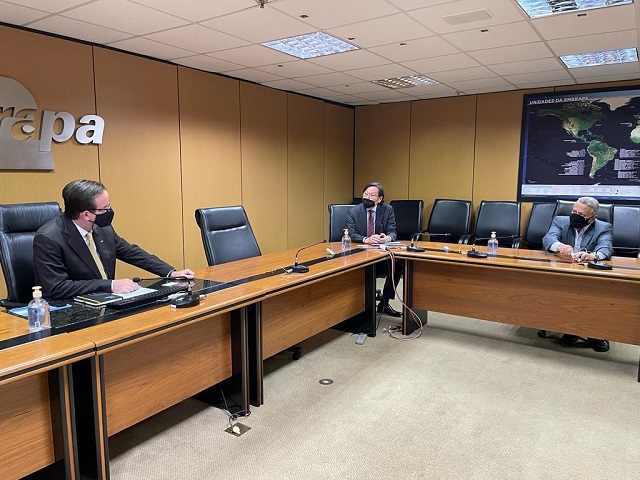Embrapa and Morocco strengthen cooperation in RD&I related to phosphorus
Embrapa and Morocco strengthen cooperation in RD&I related to phosphorus
Photo: Fernanda Diniz

Moretti, Takenaka and Rodrigues discuss interaction in research on the mineral
There are four pillars that guide this partnership: innovation, education, customization and sustainability.
In a visit to Embrapa on Wednesday (Jan 19), the president of the Office Chérifien des Phosphates (OCP) in Brazil, Olávio Takenaka, stated to the president of Embrapa, Celso Moretti, the Moroccan company's interest in expanding and diversifying cooperation between the two countries. Today, OCP is the company that has the monopoly of phosphorus in Morocco, a country that has about 70% of the world's known reserves of the nutrient, and it is the largest supplier of phosphorus to Brazil (about 40% of phosphorus imports).
However, the expectation is to transcend the commercial bias and add new value to this partnership based on four main pillars: innovation, education, customization and sustainability. The former Brazilian minister of Agriculture, Roberto Rodrigues, who works today as OCP's strategic consultant, and Embrapa's directors of R&D, Guy de Capdeville, and of Innovation and Technology, Adriana Martin, also participated in the meeting.
One of Takenaka's goals is to involve Université Mohammed VI Polytechnique (UM6P) in the cooperation between OCP and Embrapa for the development of joint RD&I especially aiming at innovations in phosphate fertilizers and prioritizing the production of phosphorus-based bioinputs.
“Moreover, we intend to encourage the exchange of knowledge among researchers and students from both countries”, stressed the president of OCP. Two Embrapa researchers have already been to the Moroccan university before the pandemic, but the goal is that this exchange of expertise becomes systemic.
There are at least three initiatives being elaborated by Embrapa and OCP featuring bioinputs, involving at least eight of Embrapa's units - Embrapa Soils, Embrapa Maize and Sorghum, Embrapa Agrobiology, Embrapa Agrosilvopastoral, Embrapa Soybeans, Embrapa Cerrados, Embrapa Environment, and Embrapa Wheat. The Moroccan company especially seeks innovation to incorporate biological inputs in their phosphate fertilizers, aiming at sustainability. Today, it has 10 branch offices located throughout Brazil, with the exception of Minas Gerais state.
Takenaka also underscored that the intention is to rely on Embrapa's experience in tailoring products to agricultural practices and agricultural regions. President Celso Moretti stressed that the capillarity of the corporation, whose research units spread through practically the entire domestic territory, will be fundamental for this process.
Embrapa's R&D section will coordinate the actions aimed at expanding and strengthening the partnership between the two institutions.
The president of Embrapa underscored that international cooperation will be one of the points of the corporation's agenda in 2022. A trip to Morocco will soon take place, when the president will visit the headquarters of both OCP and UM6P.
In addition to the on-site visits, as soon as the African country open the borders (which are closed today in light of advance of the Omicron variant), virtual meetings with the RD&I teams of the three institutions, Embrapa, OCP and UM6P, were suggested.
Cooperation for AfricaThe OCP, which is headquartered in Casablanca, has branch offices in 14 African countries today. Another focus of the closer ties between the two institutions is to contribute to the development of agriculture in the continent. According to Moretti, this is about a priority since Africa has 65% of the world's arable lands and 400 million hectares of savannahs in the sub-Saharan area. “Embrapa can significantly contribute to the agricultural development of the continent with its experience in tropical agriculture, which resulted in the development of varieties that are adapted to subtropical and tropical conditions, such as grape, barley and tropical wheat, among others”, he stated. The president also highlighted the corporation's participation in the Brazilian government's National Fertilizer Plan, which aims to increase the production and subsequent offer of national fertilizers (fertilizing, correction and conditioning agents), and thus reduce dependence on imported products and increase competitiveness in the international market. Moretti also talked about BiomaPhos, the first inoculant developed with national technology for phosphorus absorption, which yielded R$ 105 million to Brazil in 2020 due to the increased productivity of soybeans and corn. The result of a public-private partnership, it should increase the fertility of over three million hectares of Brazilian soils by the 2021/2022 harvest. |
Fernanda Diniz (MtB/DF 4685/89)
Secretariat of Research and Development (SPD)
Press inquiries
fernanda.diniz@embrapa.br
Phone number: +55 61 3448-4364
Translation: Mariana Medeiros (13044/DF)
General Secretariat
Further information on the topic
Citizen Attention Service (SAC)
www.embrapa.br/contact-us/sac/
